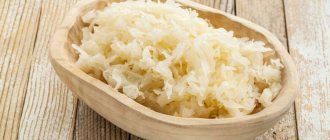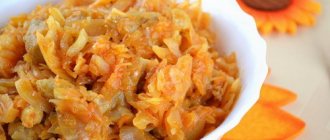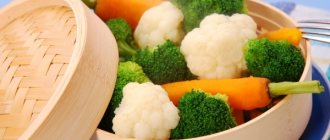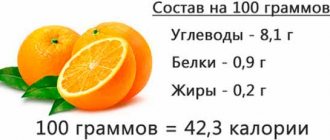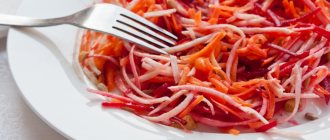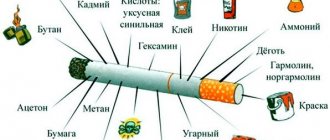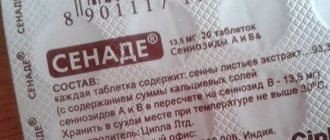Sauerkraut contains almost the entire set of vitamins. In addition to a large amount of vitamin C, it contains B vitamins (B1, B2, B5, B6, B9), as well as potassium, calcium, zinc, selenium, iron, iodine, phosphorus and sodium. In addition, fiber and dietary fiber contained in cabbage help normalize digestive processes, strengthen the walls of blood vessels and reduce blood sugar levels.
Like other fermented foods, sauerkraut helps the body better absorb nutrients and improves immune system function. But, despite the whole range of useful properties, this product can not be consumed by everyone.
Iron pan and summer varieties. 8 mistakes when sauerkraut Read more
Why does cabbage make your stomach bloat?
Almost all varieties of cabbage consist of coarse fiber. On the one hand, fiber is needed by the body and is good for the intestines. On the other hand, its digestion requires a large number of protein molecules and increased work of the digestive organs.
Did you know? The presence of sulfur allows cabbage juice to be used for gastrointestinal ulcers and gastritis. Every day for several weeks, take 2 times 100 ml of young cabbage juice with the addition of a teaspoon of olive oil.
The digestive system, which is poorly functioning due to diseases or age-related changes, has difficulty digesting such food. This causes excess gas and constipation. The unpleasant odor produced by this is aggravated by the presence of sulfur compounds in this vegetable.
Strengthening the immune system
Evidence-based medicine confirms that vitamins A, B6, B12, C, D, E, folic acid, as well as iron, zinc, copper and selenium mutually enhance each other’s effects and support the protective activity of immune cells.
Evidence-based medicine also confirms that regular intake of vitamin C reduces the duration and severity of colds - in adults by 8%, in children by 14%.
The daily requirement of vitamin C is met by taking 300g of sauerkraut with brine.
What to do and how to get rid of it?
If eating white cabbage dishes has caused such an unpleasant phenomenon as bloating, then you can get rid of it with pharmaceutical drugs or folk remedies.
Drug therapy
The following groups of medications can help get rid of flatulence:
- Enterosorbents - activated or white carbon, "Sorbex", "Smecta", "Neosmectin", "Polysorb", "Polifepan", "Entegnin". They absorb excess gases and harmful substances and activate the digestive tract.
- Defoamers - “Espumizan”, “Infacol”, “Bobotik”, “Kuplaton”. These drugs crush large bubbles, which improves their absorption and excretion.
- Prokinetics - Motilium, Domperidone, Trimedat. They promote better intestinal motility.
- Antispasmodics - “No-shpa”, “Spazoverin”, “Spazmol”, “Biospa”. They will help if bloating is accompanied by pain.
- Combined medications - “Meteospasmil”, “Pankreoflat”, “Pepfiz”. "Meteospasmil" includes a combination of an antispasmodic and a sorbent, and the last two drugs consist of antifoaming agents and enzymes that promote better absorption of food.
Folk remedies
There are many folk recipes to get rid of flatulence:
Check out
The harm and benefits of red cabbage for the human body
- Infusion of fennel seeds (dill, caraway, anise). When preparing a medicinal infusion, 2 teaspoons of seeds are brewed with a glass of boiling water and left for several hours. Consume ¼ cup 4 times a day.
- Chamomile tea . Relieves spasms and pain, soothes mucous membranes. Take 1 tbsp. spoon of dry raw materials from the pharmacy and pour 200 ml of boiling water. Leave for 20–30 minutes and strain through a sieve. Drink 2–4 times a day, ½ glass.
- Mint tea. Pour 250 ml of boiling water 2 tbsp. spoons of mint and drink throughout the day before meals.
- Herb tea. A drink made from equal parts of chamomile, lemon balm and oregano will be useful. Leave for 30 minutes, 1 tbsp. spoon of a mixture of these herbs in a thermos and drink a glass 3 times a day.
- Infusion of parsley root . Pour 3 teaspoons of raw material into a glass of boiling water and leave for 8–10 hours. Consume 1 tbsp before meals. spoon of infusion 3-4 times a day.
- Herbal collection. Take a mixture of 1 part mint, 2 parts chamomile, 2 parts dill seeds, 2 parts marshmallow root and 2 parts licorice rhizome. Pour 1 tbsp. spoon the mixture with a glass of boiling water and cover with a lid for 40 minutes. Strain through a fine sieve or cheesecloth and drink several times a day.
The removal of gases from the intestines is facilitated by massage of the abdomen in a clockwise direction.
Improved brain activity
Including probiotics in sauerkraut and brine improves intestinal microflora.
Evidence-based medicine confirms the connection between dietary intake of beneficial microorganisms and mood, brain function, and mental health (depression, anxiety).
Monoamine oxidase inhibitors (MAOIs), used in medical practice, are used against a variety of mental conditions, including depression, anxiety, and eating disorders.
For these disorders, sauerkraut and brine should be strictly limited, which is confirmed by the study.
In Ancient Rus' it was believed that sauerkraut brine helped with epilepsy.
Other foods that cause flatulence
It's not just cabbage that causes bloating.
Important! If all gas-forming foods are excluded from the diet, and the stomach continues to swell, you should undergo a medical examination. This situation can be caused by intestinal parasites, dysbiosis, inflammation and gastrointestinal disease.
There are other foods that cause gas:
- beans, soybeans, peas;
- radish, turnip, radish;
- onion;
- mushrooms and artichokes;
- whole grain products, bakery products;
- all cereals except rice;
- grapes, pear, apricot, sweet cherry, cherry, plum, apple, peach, melon, fig, date;
- Jerusalem artichoke;
- carbonated drinks, beer, kvass and juice;
- milk, kefir, fermented baked milk, ice cream.
Do not forget about the known gas-forming combinations of products:
- legumes with black bread;
- milk with bread, fish or meat, sour fruits;
- sweet juices with protein, starchy or salty foods;
- jelly with sweets.
Important! When taking dairy products, flatulence occurs due to a lack of the enzyme lactose in the human body.
Types of constipation
Alternative treatment for long-term constipation is possible, but only under the supervision of a doctor and as an addition to drug therapy. It is imperative to combat this pathology, otherwise there is a risk of self-poisoning of the body due to stagnation of feces. If there are no contraindications to the use of sauerkraut, it can be used as a remedy for the following types of constipation:
- Atonic constipation develops against the background of intestinal motility disorders, as a result the urge to defecate disappears, and the movement of feces slows down. The development of pathology is caused by moving, psychological factors, etc.
- Drug-induced constipation occurs as a result of taking certain medications (iron-based products, aspirin, antidepressants, etc.)
- Alimentary constipation is caused by poor diet, excessive consumption of flour and sweet foods and insufficient intake of water, plant foods, etc.
- The development of hypodynamic constipation is explained by insufficient physical activity; most often this type of pathology occurs in people who are forced to spend a lot of time in a supine position.
- Constipation due to dehydration (cabbage pickle is recommended).
- Constipation due to dysbiosis can be cured with sauerkraut containing lactic acid.
How to cook cabbage so that your stomach doesn't bloat?
The vegetable will not swell too much if it is heat treated. When boiled, baked or stewed, cabbage does not cause gas as much. You can prepare dishes such as stewed cabbage in tomato, vegetable stew with cabbage, cabbage soup, borscht. A combination of cooked cabbage with rice or beets will be useful, since the latter help with the accumulation of gases in the intestines. Eating a fermented product does not cause severe flatulence.
Improved digestion
A lot of microorganisms live in the intestines. The influence of many of them on physiology has been well studied.
First of all, the metabolic activity of enzymes in sauerkraut and juice, which break down nutrients into smaller ones that are more suitable for absorption, protects and has a positive effect on the intestinal epithelium, immunity, and counteracts foreign microorganisms - sources of various diseases.
Disruption of microflora can play a role in pathologies such as inflammation or intestinal tumors.
Sauerkraut and juice contain lactic acid bacteria Lactobacillus plantarum, L. pentosus, L. brevis, L. acidophilus, L. fermentum, Leuconostoc fallax and L. mesenteroides.
Therefore, the benefits of sauerkraut juice are enhanced by fermentation, which creates conditions for the growth and development of probiotics - beneficial microorganisms. They convert the sugars contained in the vegetable into organic acids and carbon dioxide.
Probiotics contain fermented milk products - kefir or yogurt. Probiotics improve the intestines’ ability to absorb vitamins and microelements, have a beneficial effect on microflora, and cleanse the intestines of rotting products.
They protect against harmful substances and bacteria, accelerate the restoration of intestinal microflora after a course of antibiotics, prevent or reduce the manifestations of diarrhea, gas formation, bloating, and ulcerative colitis, which is confirmed by the study.
The article claims that 1g of sauerkraut contains 1000-100 million colony-forming units (CFU), and one serving can contain up to three dozen different strains.
The intake of probiotics improves the balance of “good” microorganisms in the intestines, which keeps the intestinal mucosa healthy.
A strong, viable colony of beneficial microorganisms strengthens the immune system.
Current understanding of evidence-based medicine of the interaction between the intestinal microbiota and the immune system in the development and maintenance of the intestinal barrier is presented in the review.
Evidence-based medicine supports the effectiveness of probiotics for childhood and antibiotic-associated diarrhea, Helicobacter pylori infection, inflammatory bowel disease (pre-cancer), female genitourinary infections, and surgical infections. The Lactobacillus rhamnosus GG strain has a beneficial effect on intestinal immunity, increases the level of IgA and other cells secreting immunoglobulins in the intestinal mucosa, and stimulates the local release of interferons.
Evidence-based medicine confirms that in the case of acute respiratory infections, taking foods rich in probiotics speeds recovery.
Which cabbage doesn't cause bloating?
Perhaps any cabbage will cause flatulence to one degree or another. In addition, it depends on the individual characteristics of the body.
The least swelling comes from soft types of this vegetable, such as:
- broccoli;
- colored;
- Brussels sprouts;
- Savoy
It should be noted that young juicy cabbage heads contain less coarse fiber than specimens for winter storage.
Therefore, it is useful and more harmless to consume young vegetables in their season. Did you know? The intestines of a healthy adult contain approximately 1 liter of gaseous compounds, and excrete up to ½ liter of gases daily. With flatulence, the volume of escaping gases can be more than 3 liters.
Cabbage can cause increased formation of gases, but heat treatment, fermentation and the consumption of milder varieties significantly reduce this phenomenon. If you have excluded cabbage and other gas-forming foods from your diet, but the flatulence does not go away, it is better to consult a doctor about this.
Weight loss
The low calorie content and high fiber content of sauerkraut allows you to eat less and keep you feeling full longer.
Choline (vitamin B4) normalizes metabolic fat processes in the body.
Some probiotics have been shown to prevent abdominal obesity due to a putative inhibition of lipid absorption, although the details of this process are poorly understood.
Eating foods rich in probiotics has also been shown to reduce weight.
Antitumor activity
The high content of ascorbic acid, as well as ascorbigen and glucosinolates in sauerkraut reduces DNA damage and the frequency of cell mutations in cancer patients.
Fermentation conditions determine a lot. For example, reducing the amount of salt increases the content of ascorbigen.
Currently, the evidence base for the use of sauerkraut for the treatment of cancer is inconclusive.
Separate studies have shown that consuming fresh and sauerkraut significantly reduces the incidence of breast cancer.
There were similar results about sauerkraut preventing the risk of prostate cancer.
Cooking method
Pickling cabbage takes place in three stages. Understanding them helps you get a truly useful product at home.
First stage
Adding table non-iodized salt extracts moisture from the cabbage. The subsequent abundant release of cabbage juice reduces the salinity of the solution. The activity of yeast and other microorganisms causes abundant gas formation. The formation of foam creates an environment for the development of “bad” microorganisms, so it is removed.
Second phase
The dominance of lactic acid bacteria decomposes sugars. The accumulation of lactic acid prevents the development of other microorganisms and unwanted processes.
Fermentation is most effective at a temperature of +20C for 5–7 days. Sauerkraut contains fewer by-products - alcohol, volatile acids. Fermentation at this temperature retains more vitamin C.
Third stage
The formation of lactic acid inhibits the activity of lactic acid bacteria. Creates favorable conditions for filmy yeast and mold, which destroy lactic acid, which reduces the nutritional, taste and external qualities of sauerkraut. Therefore, it is optimal to store the finished product at a temperature from 0 to –2C.
Homemade sauerkraut recipe:
- Grate 2-3 carrots, finely chop 1-3 cloves of garlic.
- Chop the head of cabbage, add carrots and garlic. Set aside one of the outer leaves.
- Add 1 tbsp. salt, mix well until cabbage juice forms.
- Place the mixture together with the resulting brine in an enamel or glass container. The brine should completely cover the cabbage. Press down from above to remove air bubbles - air promotes the proliferation of harmful microorganisms.
- Place a cabbage leaf on top, press it with a plate, on which place a jar of water.
- Sauerkraut for 1 to 4 weeks at room temperature in a shaded place.
The larger the head, the sweeter and tastier the finished product. The longer the fermentation, the more pronounced the flavor. The sample can be taken within a week.
A little history
Historical facts in which there is the first mention of sauerkraut can be found in the chronicles of the construction of the Great Wall of China. Then it was fed to the workers involved in the construction of the structure. This was in the third century BC.
If you were able to visit Korea, then most likely the locals were able to say that their country is the birthplace of sauerkraut. Known to many, sauerkraut called “kimchi” is still prepared for residents and guests of the country. The Germans and Australians also have something to show. Their dish is called shakrut. In Romania, it is impossible to prepare the national dish called sarmala without sauerkraut. Poles use sauerkraut to produce traditional bigos.
There is no point in arguing about when and who first started making sauerkraut. But we can say with confidence that only in Russia this snack is consumed in large quantities. It is added to soups, cakes and main courses. This can be an addition to meat, fish and even baked vegetables. Our country has preserved a huge number of recipes for sauerkraut.
Today we will find out the secret of the popularity of this dish, analyze the composition, nutritional and caloric value of the juice, as in the case of the most valuable nutrients.
Application in cosmetology
The juice is successfully used for cosmetic purposes. Thanks to the content of lactic acid, as well as a complex of microelements and vitamins, you can get a double positive effect:
- skin cleansing;
- skin rejuvenation and improvement of complexion.
Other benefits of juice:
- By rubbing the juice into your face, you can get rid of enlarged pores and excessive oily skin. Girls notice that the signs of acne on their skin disappear and their skin looks better.
- The drink, prepared according to the rules, brightens the skin, eliminates pigmentation, freckles and other spots. To do this, you just need to apply a napkin soaked in juice for 15 minutes. The procedure should be completed in one day, and after a month you will see the result.
- If you use ice juice, you can use it to tighten your skin and make it firm and elastic.
- Bathing with the juice from your hands will help you forget about exfoliating and roughing your hands.
It should be remembered that cosmetic procedures are carried out using sauerkraut without adding vinegar ! Otherwise there will be no positive effect; on the contrary, it is dangerous.
